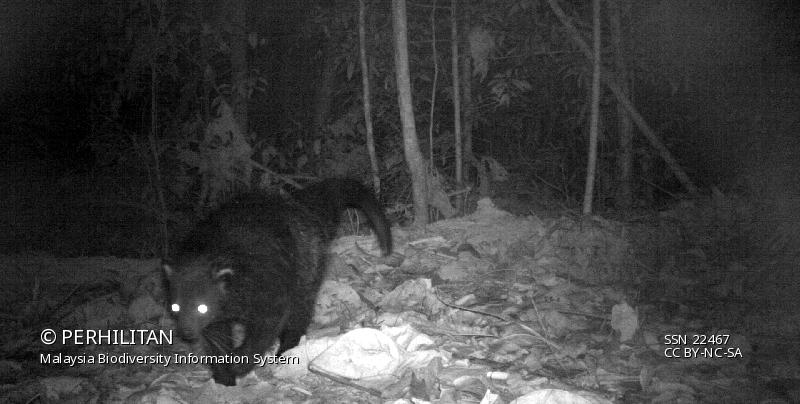
Arctictis binturong, commonly called Binturong or bearcat, is the largest species in the Viverridae family, weighing 6 to 10 kg (Phillipps & Phillipps, 2016) with a body length ranging from 61 to 96 cm and an almost equally long tail of 56 to 89 cm (Nowak, 1999). Long black hair covering its body resembling a grizzled shaggy coat and small rounded ears with long tufted hairs make it unique and easy to identify. Additionally, it is the only civet that possesses a prehensile tail which is covered with large bristling hairs. It can twist its tail around branches to act as an anchor during feeding. When mature, the female is about 20 percent heavier than the male (San Diego Zoo, 2012).
The Binturong is well distributed in China, South Asia as in India, Nepal and Bangladesh, as well as in South-east Asia, namely, Malaysia, Cambodia, Myanmar, Thailand, Vietnam, Philippines (Palawan) and Sumatra, Kalimantan and Java in Indonesia (Willcox et al., 2016). In Malaysia, Binturong has been detected in the canopy forest of Temengor Forest Reserve in Perak, the important habitat linkage known as Primary Linkage 7 in Terengganu, Danum Valley in Sabah, and Lambir Hills National Park in Sarawak (Mohd. Azlan & Engkamat Lading, 2006; Magintan et al., 2010; Hedges et al., 2013; Phillipps & Phillipps, 2016).
The Binturong is mainly arboreal and lives in the canopy (Khan, 1992). During the day it spends most of its time sleeping high in the forest canopy but is typically active at night and comes out at dusk to forage for food (Khan, 1992). As an omnivore, the binturong’s diet includes a variety of fruits especially figs, small mammals, birds, earthworms, fish and insects (San Diego Zoo, 2012).
The Binturong uses scent markings to communicate (Cosson et al., 2007; San Diego Zoo, 2012). Both sexes have scent glands on either side of their anuses and the female has another pair of scent glands around its vulva. When the binturong climbs a tree, the glands secrete scent on the branches it passes through, allowing others to locate it (Cosson et al., 2007). The scent smells distinctly like popcorn (San Diego Zoo, 2012). Apart from scent markings, the binturong also produces vocal calls such as loud howls, low grunts, and hisses for communication purposes. It also produces chuckling noises to indicate that it is happy and a high-pitched wail when upset (San Diego Zoo, 2012). In addition, the female will create a purring sound when receptive to copulate (Wemmer & Murtaugh, 1981).
The Binturong also plays a vital role in the ecosystem, especially as a dispersal agent for various fruit trees; the seeds passed through its faeces help to regenerate the forest. In addition, the binturong also serves as a natural pest controller since it can catch and eat rodents as well as insects (San Diego Zoo, 2012).
In terms of conservation status, the IUCN Red List of Threatened Species has listed A. binturong as vulnerable (VU). Its population is now at risk mainly due to habitat deterioration as a result of logging activities and deforestation, the pet trade, as well as poaching activities for fur and traditional Asian medicine (San Diego Zoo, 2012; Willcox et al., 2016). Therefore, multiple strategies and conservation efforts must be taken to ensure the sustainability of this unique species in Malaysia and throughout its natural range.
